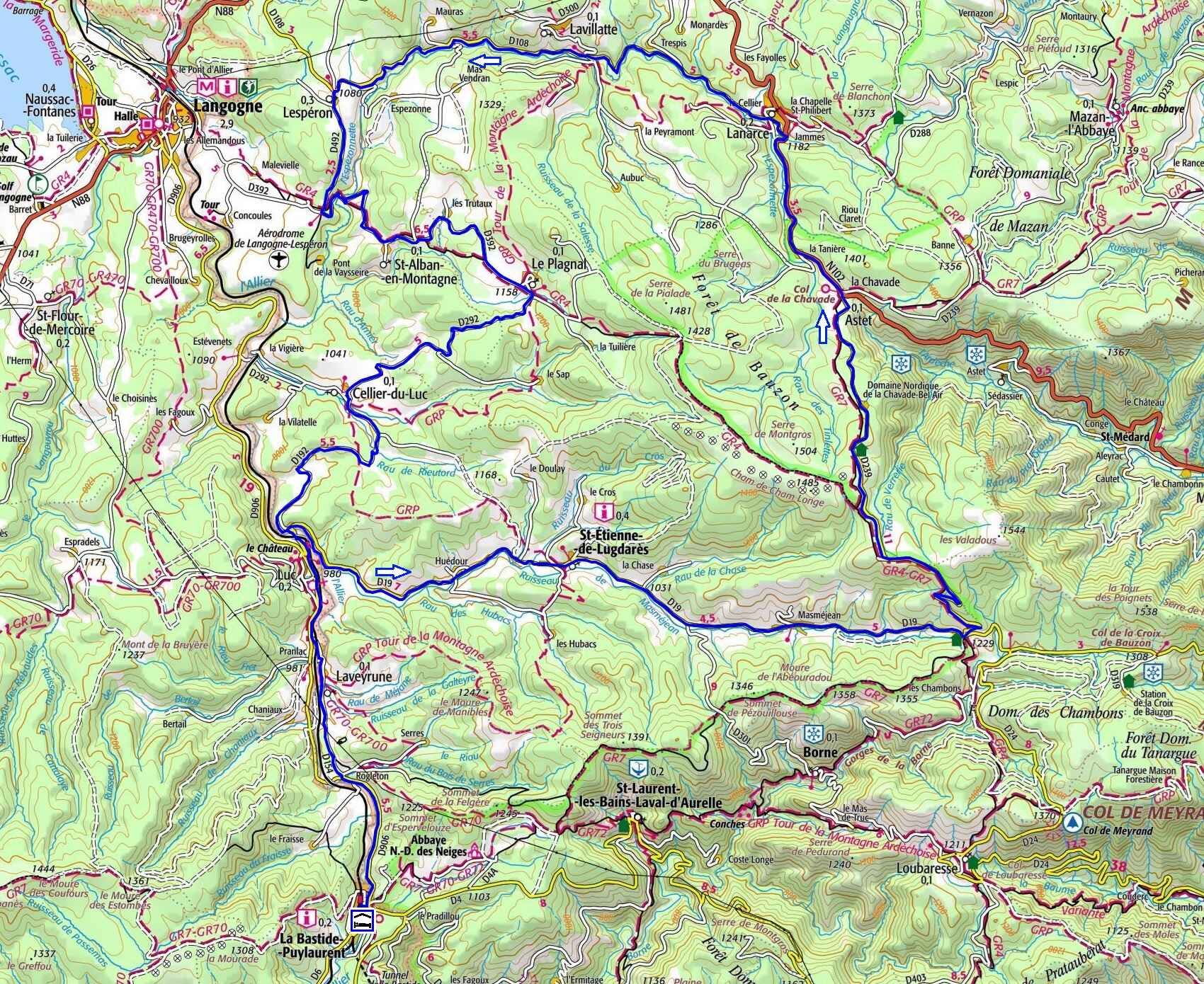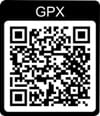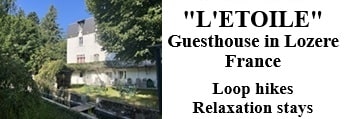76,8km bike tour at La Bastide-Puylaurent |
Take the D906 towards Langogne to Rogleton, then turn right onto the D154 towards Pranlac, passing through Laveyrune and the Allier bridge. Then take the D906 again to Luc, where you will have to turn right. After crossing the bridge over the Allier, turn right onto the D19 to reach the Col du Bez, passing through Huedour, Saint-etienne-de-Lugdares and Masmejean. At the Col du Bez, turn left onto the D239 towards La Chavade, crossing the Col du Pendu and Bel-Air. Then turn left onto the N102 to Jammes, at the entrance to Lanarce. From there, take the D108 on the left towards Lesperon, following the Espezonnette river. Then turn left onto the D492 until the intersection with the D392, then take the latter on the left to reach Le Plagnal via Saint-Alban-en-Montagne. Finally, turn right onto the D292 towards Le Cellier-du-Luc, via Chase-Neuve. Continue left onto the D192 until Luc, via Lembrandes, then join the D906 towards La Bastide, passing through Pranlac, Laveyrune and Rogleton.

20,5km - 25km - 27,7km - 30km - 35,2km - 37km - 41,5km - 44km - 48,4km - 57,5km - 59,4km - 60km - 60,5km - 69km - 70km - 76,8km - 77km - 81km - 90km - 95,7km
Google Maps - Google Earth - GPX







 Distance: 76.8km. Maximum altitude: 1428m. Minimum altitude: 932m. Cumulative elevation: 888m.
Distance: 76.8km. Maximum altitude: 1428m. Minimum altitude: 932m. Cumulative elevation: 888m.
IGN maps: Langogne (2737E). La Bastide-Puylaurent (2738E). Lake Issarles Thueyts Sources of the Loire (2837OT). Largentiere la Bastide-Puylaurent Vivarais Cevenol (2838OT).
Print the route - Electric bike rental
The Ardeche mountains, culminating at around 1,500 metres with emblematic peaks such as Mont Gerbier-de-Jonc, the source of the Loire, are a region marked by their characteristic volcanic formations, called "sucs". It attracts lovers of nature and outdoor activities: hiking and discovering landscapes in summer, cross-country skiing and snowshoeing in winter. This region is home to a variety of flora and fauna, adapted to a harsh mountain climate, which also influences its traditional architecture. The local culture is rich in mountain traditions, with emblematic local products such as blueberries, chestnuts and local cheeses. The authenticity of the Ardeche mountains, its agricultural heritage and its preserved character make it a unique and timeless destination.
The Gevaudan region, including part of the current Ardeche mountains around Saint-etienne-de-Lugdares, is distinguished by its wild landscapes, its rural heritage and a significant event: the story of the Beast of Gevaudan. Historically, Gevaudan, which corresponds to current Lozere and part of Ardeche, is a territory of plateaus and mountains with harsh living conditions. Influenced by various lordships and the Church, the medieval region was organized around agricultural villages such as Saint-etienne-de-Lugdares, where the inhabitants lived mainly from livestock and crops adapted to the mountain climate. Between 1764 and 1767, the region was hit by deadly attacks attributed to a creature nicknamed the "Beast of Gevaudan". This creature, described as an animal close to the wolf but of impressive size, killed many people, especially in Lozere but also near Saint-etienne-de-Lugdares, and sowed panic in isolated villages. Although royal hunters were sent to kill it, the exact identity of the Beast has never been confirmed, leaving a mystery that continues to feed the legend.
The castle of Luc, located in Lozere and perched on a rocky spur overlooking the Allier valley, is a witness to the rich hours of Gevaudan, a former French province with many historical conflicts. Built between the 6th and 10th centuries, it belonged to the lords of Luc, allied to the House of Joyeuse. The imposing fortress, with its square keep, towers and curtain walls, played a strategic role of defense on the Regordane way, an important axis between Languedoc and Auvergne. Over the centuries, the castle was at the heart of major events: feudal wars, crusades, religious conflicts and a siege by the Camisards in 1703. Its lords, renowned for their bravery and piety, were powerful and respected, offering protection to pilgrims and the needy. In the 16th century, the Wars of Religion between Catholics and Protestants deeply marked the castle, but a royal garrison ensured its defense. The castle was destroyed under Richelieu in 1630, losing its military function, then gradually fell into ruins. However, in 1878, a chapel and a statue of the Virgin were installed in its keep, transforming the site into a place of pilgrimage. In 1986, classified as a historical monument, the Château de Luc began a new restoration thanks to an association of volunteers, thus preserving this precious vestige of the feudal and religious heritage of Gevaudan.
